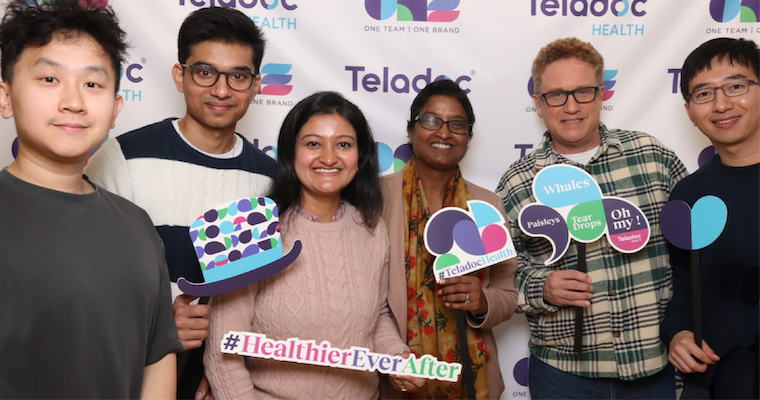
The Problem-Solvers
Student consultants leverage business savvy and technical skills to tackle real company challenges in Leavey’s Industry Practicum.

Corporate networking giant Cisco Systems needed a better way to accelerate its automated process for merchandise returns. Semiconductor equipment manufacturer Lam Research sought a new approach to scouting companies that could be future acquisition targets. Gilead Sciences wanted a predictive machine learning model to assist with developing biosciences therapies.
Aside from facing common business challenges, these companies — and dozens more from Silicon Valley — have another thing in common. They didn’t turn to major consulting companies for solutions; they turned to Leavey School of Business master of science students.
Through the school’s Industry Practicum program, graduate students in business analytics and information systems gain experience solving practical problems. In turn, companies get exposure to fresh thinking on everything from machine learning and AI to data warehousing.
The practicum program features an impressive roster of industry partners, in large part thanks to “good old-fashioned networking,” says Charlie Goldenberg, program director and professor in information systems and analytics. Goldenberg spent most of his career as a consultant for KPMG, Deloitte and Cognizant, so he calls upon his own experience working with Silicon Valley’s tech companies to find partners.
And, of course, he and fellow faculty call upon the school’s extensive alumni network. For the 2024 program, eight of the partner companies are sponsored by alumni. Most important to Goldenberg, 19 of the 22 projects this year are for repeat partners — companies like Cisco and Box that have already worked with students in the past and came back for more.
“Once a company works with us, there's a good likelihood they're going to work with us again because they've had a positive experience working with our students,” Goldenberg says.
The Real Challenges of Consulting
In practical terms, the Industry Practicum works much like any consulting project would. Each partner company ends up with a team of three to four students, plus a faculty advisor, with a mix of appropriate skills to solve the challenge at hand.
To reach that point, Goldenberg and colleagues first put together a list of partner companies, along with a summary of problem statements and work scopes. Next, students identify their own preferred projects based on their expertise and interests. In turn, faculty advisors also must consider the skillset each student brings to a potential team.
For instance, does a student already have expertise or experience in building AI or machine learning models? Do they have a deep understanding of data warehousing? What communication and leadership skills have they displayed?
Communication and adaptability skills are often just as important as technical skills. Goldenberg points out that real-world problems can be much messier than the clean data-sets presented in a classroom set.
That’s also a key point for Christos Matheou, digital transformation manager for Cisco and a Leavey alumnus. “It’s great to be able to give students the real-world challenges in terms of things not being so complete or perfect. How do you get around that? These are some of the things that I wish I would’ve realized early on.”
Multiple teams of Leavey students have worked on projects for Cisco, specifically tackling the company’s return merchandise authorization (RMA) process for faulty products. They’ve analyzed the process and developed key hypotheses about pain points — both for the company and for customers submitting RMAs. Ultimately, they’re working toward a more automated process that uses AI and machine learning to minimize unnecessary returns and smooth the process for legitimate ones.
Matheou says the fresh perspective and skills from students help breathe new life into the process. “I think that’s been very impressive — how our students look at problem-solving, and how we can improve the business together.”
Value for Companies and Students
The Lam Research team asked Leavey student consultants to develop a web-scraping tool to help its scouts identify the best companies to seek as future acquisition targets. To do so, the students faced hurdles such as web tools that block web-scraping, but ultimately overcame them with coding and technical, creative problem-solving. The students received a lesson in adaptability, and the company received a working tool that loads data into a spreadsheet for easy analysis by Lam scouts. The student team even went above and beyond and created an additional tool that scans fundraising emails for potential partners. Lam estimates the tool reduces the company’s scouting time by upwards of 50–70 percent.
“Start small, prototype, assess results and then make the next move,” is how the company describes the project in its own newsletter. “Lam’s Tech Scouting team and data science graduate students from Santa Clara University (SCU) put this theory into practice and the partnership resulted in a real productivity tool.”
Experience with practical problem-solving is one benefit for students. So is honing skills such as writing reports or managing communications with clients.
“Report writing is an important part of what you need to learn to be effective in industry,” Goldenberg says. “So they're essentially putting together a consulting report that they're going to deliver to the companies at the end of each project. Communication is so important. You have to have good written and oral communication to essentially converse with the company, to provide them with information, and to sell your ideas at the end.”
Students and graduates who have gone through the Industry Practicum agree.
“It helped me to understand what questions to ask,” says Rutuja Ramesh Pathade, a master’s student in information systems and previous program participant. “You have to communicate your ideas to a wider audience always. It’s not always technical, but also you have to be able to talk in business terms. So talking to my teammates in terms of technical aspects and then making a quick switch to apply my ideas in a business sense actually helped me hone my skills and present my ideas on the spot to a wider audience.“